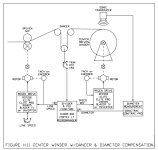Puddle
Member
I've never done this before but it seems like something that will have been done a thousand times in the past.
Centre winder is currently manually controlled, rolls are all over the place. Winder is being used to re-roll web at the end of a production line.
Components:
-S7-1510 CPU
-Siemens G120c
-Keyence LR-TB5000 (Distance laser with analog out)
-Re SPA. T-one (load cell converter with 0-10v output)
I'm thinking I'll get a good result by using a calculation of line speed and roll diameter to get the speed to match, then use the load cell feedback to limit torque.
Potential problems that I can see:
-Getting the calculations wrong
-Response speed. G120c has a single AI connection, which will be the laser. Load cell will be connected to the PLC, filtered through a PID block and then sent to the drive via profinet.
-I'll never ever get it right and I need encoder feedback for full torque control, which the G120c hasn't got.
Drive experts, please let me know if there's anything I've missed. I've been reading up on tension control and the re-wind calculations don't look too complex.
Centre winder is currently manually controlled, rolls are all over the place. Winder is being used to re-roll web at the end of a production line.
Components:
-S7-1510 CPU
-Siemens G120c
-Keyence LR-TB5000 (Distance laser with analog out)
-Re SPA. T-one (load cell converter with 0-10v output)
I'm thinking I'll get a good result by using a calculation of line speed and roll diameter to get the speed to match, then use the load cell feedback to limit torque.
Potential problems that I can see:
-Getting the calculations wrong
-Response speed. G120c has a single AI connection, which will be the laser. Load cell will be connected to the PLC, filtered through a PID block and then sent to the drive via profinet.
-I'll never ever get it right and I need encoder feedback for full torque control, which the G120c hasn't got.
Drive experts, please let me know if there's anything I've missed. I've been reading up on tension control and the re-wind calculations don't look too complex.






